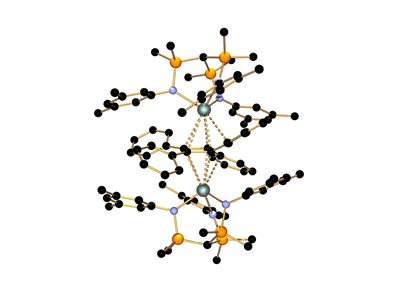
Colour key for figure: green = uranium; black = carbon; blue = nitrogen; orange = silicon.
Research published in the leading journal Nature Communications has reported the first examples of four-membered carbon-based rings bonded to uranium. Cyclobutadienyl rings are a fundamentally important type of aromatic system which until now have predominantly been utilised in organometallic transition metal chemistry.
The work was carried out by Dr Dipti Patel, a postdoctoral researcher in the research group led by Professor Steve Liddle. Dipti was an undergraduate student at Nottingham prior to commencing a PhD at Nottingham. Dipti has been a postdoctoral researcher at Nottingham since 2008 following the completion of her PhD.
Despite the birth of organouranium chemistry in 1956 with the coordination of a C5 aromatic ligand to uranium, and the subsequent discovery that aromatic rings containing six, seven, and eight carbon atoms could be bonded to uranium, the four-membered relatives of this series remained elusive. Now, nearly sixty years on from the inception of the area a way to install cyclobutadienyl rings at uranium has been devised. The reaction involves reductively coupling two diphenylalkyne molecules together at uranium which provides the electrons needed to provoke the reaction. This reaction was established decades ago for the transition metals, and this study shows once again that uranium can behave like the transition metals.
Professor Liddle said: “We are delighted to have obtained this long elusive piece of the jigsaw. With one of the last pieces of the puzzle in place, we can now look at the way the chemical bonding of uranium changes when it is bonded to aromatic ligands of varying size from four to eight carbon atoms. What we see is that uranium utilises both its f and d orbitals to different extents depending on the size of the ring. We anticipate that this knowledge will help us in designing new compounds in the future.”
The research has been funded and supported by the Royal Society, European Research Council, Engineering and Physical Sciences Research Council, and the National Nuclear Laboratory.
Citation: D. Patel, J. McMaster, W. Lewis, A. J. Blake, S. T. Liddle, Nat. Commun., 2013, 4, 2323, doi:10.1038/ncomms3323.
Colour key for figure: green = uranium; black = carbon; blue = nitrogen; orange = silicon.
Posted on Friday 20th September 2013